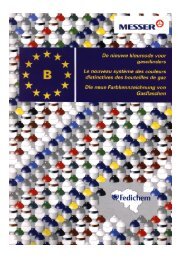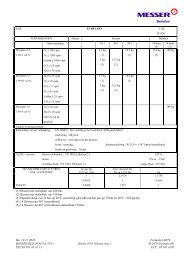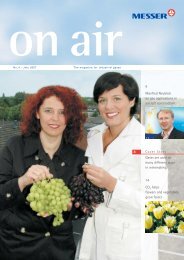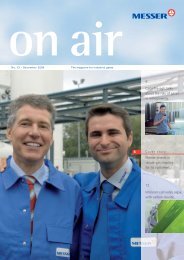8 6 Helmut Gutenberger and Wojciech Pastuszczyn on ... - Messer
8 6 Helmut Gutenberger and Wojciech Pastuszczyn on ... - Messer
8 6 Helmut Gutenberger and Wojciech Pastuszczyn on ... - Messer
Create successful ePaper yourself
Turn your PDF publications into a flip-book with our unique Google optimized e-Paper software.
<strong>on</strong>ly leads to unwanted deposits; the solid calcium<br />
carb<strong>on</strong>ate, due to its high degree of whiteness, also<br />
has a very big influence <strong>on</strong> the whiteness of the paper.<br />
We raise the pH value by adding carb<strong>on</strong> dioxide from<br />
<strong>Messer</strong>, which reduces the dissoluti<strong>on</strong> of calcium carb<strong>on</strong>ate.<br />
Though carb<strong>on</strong> dioxide also forms a mild acid<br />
– carb<strong>on</strong>ic acid – when dissolved in water, it has a<br />
bacteriostatic effect <str<strong>on</strong>g>and</str<strong>on</strong>g> therefore inhibits the growth<br />
of microbes in a natural way.<br />
<strong>on</strong> air: Is the use of carb<strong>on</strong> dioxide really a good<br />
choice in terms of envir<strong>on</strong>mental compatibility?<br />
<str<strong>on</strong>g>Helmut</str<strong>on</strong>g> <str<strong>on</strong>g>Gutenberger</str<strong>on</strong>g>: We obtain most of the carb<strong>on</strong><br />
dioxide from industrial waste gas, thereby preventing<br />
the CO2 from getting into the atmosphere in the first<br />
place. Instead it is used in processes in which its role<br />
is to prevent envir<strong>on</strong>mental polluti<strong>on</strong>. In the aforementi<strong>on</strong>ed<br />
example, the carb<strong>on</strong> dioxide is completely<br />
dissolved in the water. A paper mill’s extremely high<br />
energy dem<str<strong>on</strong>g>and</str<strong>on</strong>g> means that its “carb<strong>on</strong> footprint” – the<br />
CO2 emissi<strong>on</strong>s during the entire process chain – is<br />
inherently very large. We are currently working <strong>on</strong> the<br />
c<strong>on</strong>cept of a “green paper mill” which produces absolutely<br />
no CO2 emissi<strong>on</strong>s <str<strong>on</strong>g>and</str<strong>on</strong>g> in which fresh water c<strong>on</strong>sumpti<strong>on</strong><br />
is reduced significantly by recycling the<br />
water. The paper industry must aim to reduce CO2, water <str<strong>on</strong>g>and</str<strong>on</strong>g> energy c<strong>on</strong>sumpti<strong>on</strong> – as must we all!<br />
Sustainability is vital. We entered the market with the<br />
aim of being the partner of choice for the paper industry.<br />
We want to c<strong>on</strong>serve resources together.<br />
<str<strong>on</strong>g>Wojciech</str<strong>on</strong>g> <str<strong>on</strong>g>Pastuszczyn</str<strong>on</strong>g>: By using CO2 we can reduce the<br />
use of biocides. Biocides get into the wastewater<br />
<strong>on</strong> air 09 · 2008<br />
where they inhibit microbiological activity, without<br />
which wastewater treatment plants d<strong>on</strong>’t work. Most<br />
paper mills have their own wastewater treatment<br />
plants; here, too, carb<strong>on</strong> dioxide can be used as an<br />
envir<strong>on</strong>mentally friendly substitute for sulphuric acid<br />
in order to achieve wastewater neutralisati<strong>on</strong>.<br />
<strong>on</strong> air: How do you achieve know-how transfer?<br />
<str<strong>on</strong>g>Wojciech</str<strong>on</strong>g> <str<strong>on</strong>g>Pastuszczyn</str<strong>on</strong>g>: I know what I d<strong>on</strong>’t know – the<br />
paper industry is developing at a rapid pace, so in my<br />
view the best way to learn is to study the processes<br />
intensively. At the beginning, I carried out system analyses<br />
at twelve Polish mills before c<strong>on</strong>cluding the first<br />
c<strong>on</strong>tract for pulp washing with carb<strong>on</strong> dioxide. After<br />
initial c<strong>on</strong>tact has been made, it can take anything<br />
from six m<strong>on</strong>ths to three or four years for a c<strong>on</strong>tract<br />
to be c<strong>on</strong>cluded.<br />
<str<strong>on</strong>g>Helmut</str<strong>on</strong>g> <str<strong>on</strong>g>Gutenberger</str<strong>on</strong>g>: Both my father <str<strong>on</strong>g>and</str<strong>on</strong>g> gr<str<strong>on</strong>g>and</str<strong>on</strong>g>father<br />
were papermakers <str<strong>on</strong>g>and</str<strong>on</strong>g> I myself have worked in the<br />
paper industry for over 20 years. I am hugely fascinated<br />
by this industry – which is why I am happy to pass<br />
<strong>on</strong> my knowledge, although the diversity factor does<br />
make transferring know-how difficult. After four years,<br />
we can say that we are very successful in the pulp <str<strong>on</strong>g>and</str<strong>on</strong>g><br />
paper sector thanks to the good working relati<strong>on</strong>ship<br />
we have with our customers, with institutes <str<strong>on</strong>g>and</str<strong>on</strong>g> with<br />
our colleagues in <strong>Messer</strong>’s European subsidiaries. To<br />
quote figures: we have sold 14 milli<strong>on</strong> cubic metres of<br />
our gases to paper manufacturers.<br />
Diana Buss, <strong>Messer</strong> Group<br />
Paper webs during the producti<strong>on</strong><br />
process. “There are just as many<br />
papermaking processes as there<br />
are types of paper”, says <str<strong>on</strong>g>Wojciech</str<strong>on</strong>g><br />
<str<strong>on</strong>g>Pastuszczyn</str<strong>on</strong>g>.<br />
Interview : 7












